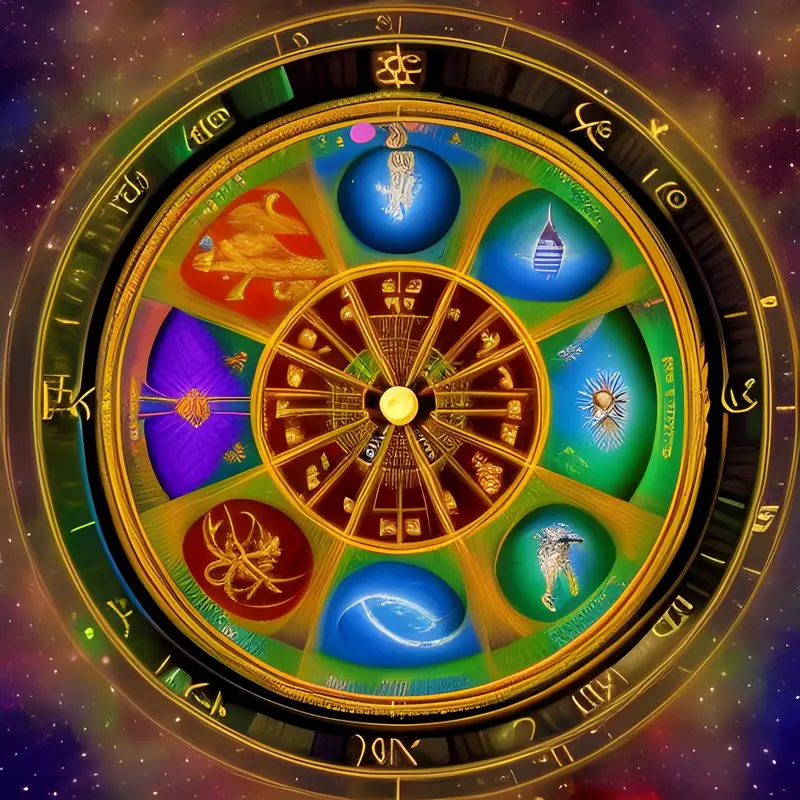Astrology has always held a fascination for those who seek to go deeper into aspects of their lives. By Understanding the Composite Chart in astrology, astrologers can gain insight into the dynamics of relationships and the compatibility between individuals. In this article, I will delve into the world of Composite Charts and explore their significance in astrology.

Why trust me? I’m a certified astrologer from Astrolada.com, certified coach from Inner-Throne.com, and certified Compassion Key practicioner from Compassionkey.com. With over a decade of experience in astrology, self-development world, and working with people.
— The Freedom Astrologer
Table of Contents
Introduction to Composite Chart in Astrology
Before we delve into the intricacies of Composite Charts, let’s first understand what exactly a Composite Chart is. A Composite Chart is a type of astrology chart that is created by combining the birth charts of two individuals to form an entirely new chart. This chart represents the dynamics, strengths, and challenges of the relationship between these two individuals.
The Composite Chart is not just a simple blend of the two birth charts; instead, it is a unique chart that represents the essence of the relationship itself. It provides a snapshot of the energy and potential that exists between two people, offering valuable insights into the compatibility and dynamics of the relationship.
Understanding the Composite Chart in Astrology?

At its core, a Composite Chart is a symbolic representation of the relationship between two individuals. It is calculated by finding the midpoint between the two individuals’ birth dates, times, and locations. This midpoint serves as the basis for creating the Composite Chart.
The Composite Chart takes into account the positions of the planets, the houses, and the aspects between them. These elements provide valuable information about the nature of the relationship, its challenges, and its potential for growth.
When examining a Composite Chart, we astrologers consider the planetary placements and aspects to gain a deeper understanding of the relationship. For example, the position of Venus in the Composite Chart can indicate the level of harmony and affection between the individuals, while the placement of Mars can reveal the level of passion and intensity in the relationship.
In addition to the planets, the houses in the Composite Chart also play a significant role. The house placement of the Sun can shed light on the overall purpose and direction of the relationship, while the house placement of the Moon can reveal the emotional needs and nurturing qualities within the partnership.
Pro-Astrologer tip for Composite Charts in Astrology: Take a look at the Composite chart when the relationship has lasted for a while (6 months or so). You will get better results.
The Role of the Composite Chart in Astrology
The Composite Chart is an invaluable tool in astrology as it offers a unique perspective on relationships. It highlights the strengths, weaknesses, and dynamics that exist between two individuals. By examining the Composite Chart, we astrologers can gain insight into the underlying dynamics of the relationship and provide guidance on how to navigate its complexities.
One of the key benefits of the Composite Chart is its ability to reveal the potential for growth and evolution within the relationship. By analyzing the aspects between the planets in the Composite Chart, we astrologers can identify areas of tension and conflict, as well as opportunities for growth and transformation.
Furthermore, the Composite Chart can also provide insights into the purpose and lessons of the relationship. It can shed light on the karmic connections between two individuals and the lessons they are meant to learn from each other. This understanding can help individuals navigate the challenges and make the most of the opportunities presented in the relationship.
The Components of a Composite Chart

Now that we have a basic understanding of what a Composite Chart is, let’s explore its different components. A Composite Chart consists of various elements that work together to provide a comprehensive understanding of the relationship.
When it comes to analyzing a Composite Chart, we astrologers delve into the positions of the planets, the houses, and the aspects. Each of these components sheds light on different aspects of the relationship, offering valuable insights into its dynamics.
Planets in a Composite Chart
In the Composite Chart, the positions of the planets play a vital role in illuminating the energies at play within the relationship. Each planet represents a different aspect of the relationship, such as communication, emotions, or desire. By analyzing the positions of these planets, we astrologers can gain valuable insights into the dynamics of the relationship.
For example, the placement of Venus in the Composite Chart can indicate the level of harmony and love between the partners. A well-placed Venus suggests a solid romantic connection, while a challenging placement may indicate difficulties in expressing affection or finding common ground.
Similarly, the position of Mars in the Composite Chart can reveal the level of passion and assertiveness within the relationship. A harmonious Mars placement signifies a healthy balance of assertiveness and cooperation, while a challenging placement may lead to power struggles or conflicts.
Houses in a Composite Chart
Alongside the planets, the houses in a Composite Chart offer additional information about the relationship. Each house represents a different area of life, such as career, family, or romance. By examining the placement of the planets within each house, astrologers can gain insight into the areas of life that will be most affected by the relationship.
For instance, if the Composite Chart shows the Sun in the 7th house, it suggests that the relationship will have a significant impact on the partners’ individual identities, as well as their interactions with others. This placement may indicate a strong emphasis on partnerships and a need for balance and compromise.
Furthermore, the placement of the Moon in the Composite Chart’s houses can reveal the emotional needs and nurturing qualities within the relationship. If the Moon is in the 4th house, it suggests that the relationship will have a profound impact on the partners’ sense of emotional security and their connection to their roots and family.
Aspects of a Composite Chart
The aspects within the Composite Chart indicate the interplay between the energies of the planets. Positive aspects, such as trines or sextiles, indicate harmony and ease within the relationship. On the other hand, challenging aspects, such as squares or oppositions, suggest areas of potential conflict or tension. By analyzing these aspects, we astrologers can provide valuable insights into the challenges and opportunities within the relationship.
For example, a Composite Chart with a harmonious aspect between Mercury and Uranus suggests that the partners have a strong mental connection and innovative ideas. This aspect fosters open communication and intellectual stimulation within the relationship.
Conversely, a Composite Chart with a challenging aspect between Saturn and Mars may indicate a struggle for control and power dynamics within the relationship. This aspect can lead to conflicts and disagreements if not handled with care and understanding.
By considering the aspects in the Composite Chart, we astrologers can provide guidance on how to navigate potential challenges and make the most of the relationship’s strengths.
How to Create a Composite Chart

Now that we understand the components of a Composite Chart, let’s explore how to create one. Creating a composite chart requires gathering the necessary information and plotting the chart accordingly.
Gathering Necessary Information
Before creating a Composite Chart, it is essential to gather accurate birth date, time, and location information for both individuals. This information is crucial as it forms the basis for calculating the Composite Chart accurately.
Pro-Astrologer tip: don’t bother with the Composite Chart if You don’t have accurate birth data. The results can be even more confusing.
When gathering birth date information, it is vital to obtain the exact day, month, and year of birth for both individuals. This ensures that the Composite Chart is calculated with precision, providing a more accurate representation of the relationship between the two individuals.
In addition to the birth date, it is also necessary to gather the exact time of birth for both individuals. The time of birth is crucial as it determines the positioning of the planets at the moment of birth, which plays a significant role in astrology.
Furthermore, it is crucial to collect the birth location information for both individuals. The birth location includes the city, state/province, and country where each individual was born. This information helps in determining the geographical coordinates necessary for calculating the Composite Chart accurately.
Plotting the Chart
Once the necessary information is gathered, it can be used to calculate the Composite Chart. There are various astrology software and online tools available that can generate the Composite Chart based on the provided information. These tools can also provide additional insights and interpretations based on the composite chart.
When plotting the Composite Chart, the software or online tool utilizes the gathered birth date, time, and location information to calculate the midpoints between the two individuals’ natal charts. These midpoints represent the blending of energies and characteristics from each individual, creating a unique Composite Chart that symbolizes the relationship between them.
The Composite Chart displays the positions of the planets, houses, and other astrological factors at the midpoint between the two individuals’ birth charts. It provides a comprehensive overview of the dynamics and potentials of the relationship, offering insights into compatibility, strengths, challenges, and areas of growth.
Once the Composite Chart is generated, it can be analyzed and interpreted to gain a deeper understanding of the relationship dynamics. The Composite Chart can reveal the overall purpose and themes of the relationship, as well as the areas where the individuals complement or challenge each other.
It is important to note that while the Composite Chart provides valuable insights, it is not meant to replace individual birth charts. Each individual’s natal chart still holds significant importance in understanding their unique characteristics and life path.
Reading and Interpreting a Composite Chart
Now that we have created a Composite Chart, it’s time to dive into its interpretation. Reading and interpreting a Composite Chart requires understanding the positions of the planets, deciphering house meanings, and making sense of the aspects.
Understanding Planetary Positions
The positions of the planets within the Composite Chart indicate the energies at play within the relationship. Each planet represents a different aspect of the relationship, such as love, communication, or conflict. By analyzing the positions of these planets, astrologers can gain valuable insights into the nature of the relationship and its potential for growth.
Deciphering House Meanings
The houses in the Composite Chart provide additional information about the relationship. Each house represents a different area of life, such as home, career, or spirituality. By examining the placement of the planets within each house, we astrologers can gain insight into the areas of life that will be most affected by the relationship.
Making Sense of Aspects
The aspects within the Composite Chart reveal the interplay between the energies of the planets. Positive aspects indicate harmony and compatibility, while challenging aspects suggest areas of potential conflict or tension. By analyzing these aspects, we astrologers can provide valuable insights into the challenges and opportunities within the relationship.
The Significance of Composite Chart in Relationships
Now that we have explored the intricacies of a Composite Chart, let’s delve into its significance in relationships.
Composite Chart and Compatibility
The Composite Chart offers valuable insights into the compatibility between two individuals. By analyzing the positions of the planets, the houses, and the aspects within the Composite Chart, astrologers can determine the level of harmony and compatibility between two individuals. This information can help individuals understand their potential for a successful relationship and work towards fostering a deeper connection.
Composite Chart and Relationship Dynamics
Furthermore, the Composite Chart provides insights into the dynamics of a relationship. By understanding the energy patterns and potential challenges within the Composite Chart, individuals can gain a deeper understanding of the dynamics at play in their relationships. This knowledge can aid in navigating conflicts, fostering understanding, and fostering growth within the relationship.
Astrology is a complex and nuanced field, and individual experiences can vary greatly based on the entirety of one’s chart. Therefore, it’s always beneficial to consult with a professional astrologer for personalized insights and guidance.
Desire a deeper understanding of your professional or romantic relationship? Explore our Pro-astrologer relationship assessment by clicking here.
The Freedom Astrologer
Work with me: https://linktr.ee/astroian888

